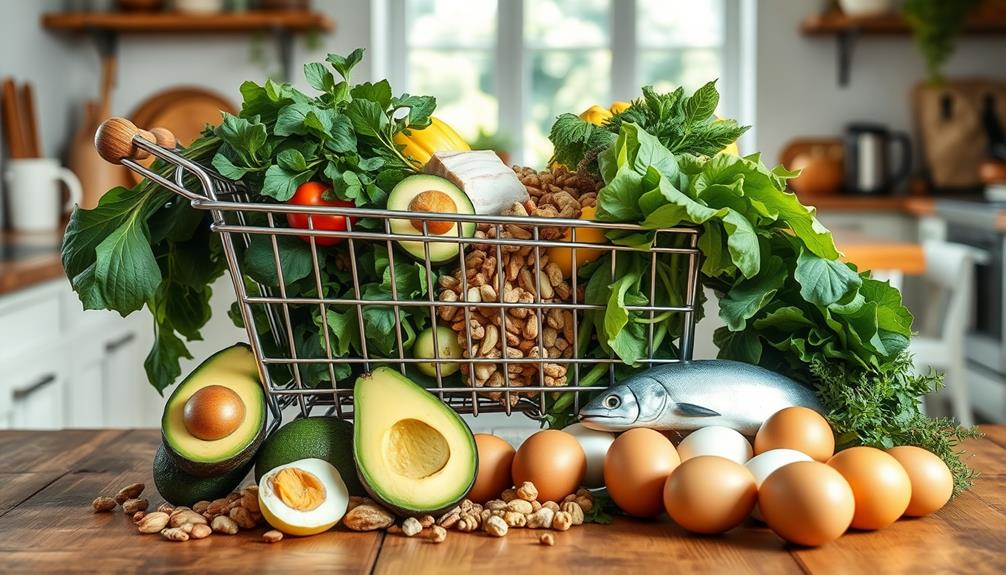Hummus can be keto diet friendly if you watch your portion sizes. A standard 2-tablespoon serving contains about 4 grams of net carbs. Just remember that larger portions can quickly increase your carb intake. To stay on track, stick to a serving size of 2-4 tablespoons and pair it with low-carb veggies like cucumber and celery. It's important to avoid dessert hummus due to added sugars. While traditional hummus has its benefits, there are also lower-carb alternatives to explore. If you want to discover more options and tips for enjoying hummus within your keto journey, keep going!
Key Takeaways
- Traditional hummus has a high carb content, with about 6 grams of total carbs per 2-tablespoon serving, making moderation essential for keto.
- Using portion control of 2-4 tablespoons helps maintain ketosis while enjoying hummus on a keto diet.
- Pairing hummus with low-carb vegetables like celery and cucumber enhances nutrition while keeping carb intake low.
- Alternatives to traditional hummus, such as baba ganoush or black soybean hummus, offer lower net carb options for keto dieters.
- Hummus can provide healthy fats and fiber, contributing positively to overall well-being when incorporated mindfully into a keto lifestyle.
Hummus and Keto Compatibility

Hummus can be a bit tricky when it comes to a keto diet. Traditional hummus packs around 49.5 grams of carbohydrates per cup, which is quite high for your daily carb limit of 20-50 grams. If you want to enjoy hummus as a dip, you'll need to be mindful of your portions. A typical 2-tablespoon serving contains about 6 grams of total carbs and approximately 4 grams of net carbs per serving, so careful measurement is essential.
Additionally, pairing hummus with low-carb options can enhance your overall health benefits, as many people find that non-starchy vegetables like celery are known for their anti-inflammatory properties.
You can still incorporate small amounts of hummus into your diet, but pairing it with non-starchy veggies like celery or broccoli can help keep your carb intake in check. These options not only add crunch but also enhance the overall nutritional value of your snack.
If you're looking for alternatives, consider trying dips made from cauliflower or avocado; they usually have lower carbohydrate content and can satisfy your cravings just as well.
Ultimately, with proper planning and moderation, traditional hummus can fit into your keto lifestyle. Just remember to use it sparingly and think of it more as a garnish than the main event.
Carb Count of Hummus

When it comes to hummus, understanding the carb count is essential for your keto journey. A typical 2-tablespoon serving can pack around 4 grams of net carbs, so you'll want to keep portion sizes in check.
Additionally, being mindful of your overall budget for food expenditures is important, especially when exploring common financial terms related to dietary choices.
If you're looking for lower-carb alternatives, there are plenty of options to explore that fit your diet better.
Hummus Carb Breakdown
For those watching their carb intake, understanding the carb breakdown of hummus is essential. A typical 2-tablespoon serving of hummus contains about 6 grams of total carbohydrates. However, when you factor in the fiber, the net carb count drops to approximately 4 grams. This is important information if you're on a keto diet, where daily carbohydrate limits generally range from 20 to 50 grams.
Additionally, incorporating diverse food options can enhance your dietary strategy, much like how Gold IRAs provide diverse investment options for building financial resilience.
If you consider a full cup of traditional hummus, it holds around 49.5 grams of carbohydrates, primarily from chickpeas. Each tablespoon adds about 3 grams of carbohydrates, so portion control becomes essential for maintaining your keto goals.
Be mindful of dessert varieties, too. These often have added sugars, greatly increasing the carb count and making them less suitable for your low-carb lifestyle.
To enjoy hummus without compromising your keto diet, keep a close eye on your serving sizes and opt for traditional flavors without added sweeteners. By understanding the hummus carb breakdown, you can make informed choices and savor your favorite dip while sticking to your dietary plan.
Serving Size Matters
Understanding the carb count of hummus isn't just about the numbers; it's also about how much you eat. For those on a keto diet, managing your serving size is essential. A typical 2-tablespoon (30-gram) serving contains around 6 grams of total carbs and 4 grams of net carbs, which can fit into your carb intake goals.
However, larger servings can easily ramp up the carb count to 8-12 grams, potentially disrupting your ketosis. Additionally, it's important to be aware of the potential side effects and interactions of any foods you consume, including hummus, especially if you're also managing other health conditions cold medications overview.
To help you enjoy hummus while staying on track, consider these tips:
- Stick to a serving size of 2-4 tablespoons to keep net carbs between 4-8 grams.
- Monitor your overall carb intake throughout the day to avoid exceeding limits.
- Be cautious with dessert hummus, as it often has added sugars that increase the carb content.
- Experiment with smaller servings to savor the flavor without overdoing it.
Alternatives to Hummus
Finding suitable alternatives to hummus can make your keto journey easier and more enjoyable. Traditional hummus packs around 6 grams of total carbs and 4 grams of net carbs per 2-tablespoon serving, which can be too high for your low-carb lifestyle. Since chickpeas contain about 45 grams of carbohydrates per cup, it's important to seek out options that won't derail your diet.
For those interested in natural remedies, consider incorporating essential oils like clove oil for various health benefits that can complement your overall wellness.
Consider trying baba ganoush, which offers about 3 grams of net carbs per 3-tablespoon serving. Black soybean hummus is another excellent choice, with just 2 grams of net carbs for the same serving size.
If you crave that creamy texture of hummus, look for cauliflower or avocado-based versions, which can provide a delicious, low-carb alternative.
You can also find prepackaged keto-friendly dips, like cauliflower hummus, at many grocery stores. These dips and spreads not only satisfy your cravings but also help you stick to your low-carb goals without sacrificing flavor.
Portion Control Guidelines

When it comes to enjoying hummus on a keto diet, portion control is crucial. A typical 2-tablespoon (30-gram) serving of traditional hummus has about 6 grams of total carbs and 4 grams of net carbs. To stay within your daily carb limits of 20-50 grams, aim for 2-4 tablespoons (30-60 grams) per serving.
Overestimating your serving size can lead to exceeding your carb allowance, disrupting ketosis. Additionally, being mindful of your overall dietary choices, like considering options with lower carb content, can enhance your keto journey. For instance, exploring investment strategies in precious metals can provide insights into alternative asset classes while managing your nutrition.
To help you manage your hummus intake while sticking to your keto goals, consider these guidelines:
- Limit servings to 2-4 tablespoons to maintain proper portion control.
- Use hummus as a garnish rather than a dip to enjoy its flavor without excess carbs.
- Avoid dessert varieties of hummus, as they often contain added sugars that spike carb content.
- Keep track of your overall daily net carbs to guarantee you stay within your keto diet limits.
Low-Carb Hummus Alternatives

If you're looking for ways to enjoy hummus while staying on track with your keto diet, there are plenty of low-carb alternatives that can satisfy your cravings. One popular option is baba ganoush, which contains only 3 grams of net carbs per 3-tablespoon serving.
Black soybean hummus is another great choice, with just 2 grams of net carbs for the same amount. Incorporating creative culinary techniques can also enhance the flavors of these low-carb alternatives.
You can also explore cauliflower and avocado-based hummus, both of which provide considerably lower carbohydrate content, making them ideal for a keto lifestyle. These hummus alternatives are rich in healthy fats and fiber, which help keep you feeling full while aligning with keto macronutrient goals. For those new to the keto diet, questions like *“is corn allowed on keto“* often arise. While corn is generally too high in carbohydrates to be considered keto-friendly, there are plenty of low-carb vegetable options to pair with these hummus varieties, such as celery sticks or cucumber slices.
Nut-based dips, like almond or sunflower seed spreads, are excellent low-carb alternatives that can keep your taste buds happy.
If convenience is key, consider prepackaged keto-friendly dips, such as cauliflower hummus, which are becoming more widely available.
For a more personalized touch, you can whip up homemade versions using ingredients like avocado or cauliflower mixed with tahini and spices.
These options allow you to create satisfying, low-carb dips that pair well with non-starchy vegetables, ensuring you stay committed to your keto diet without sacrificing flavor.
Pairing Hummus With Vegetables

When you pair hummus with low-carb vegetables, like celery and raw broccoli, you'll keep your carb intake in check while enjoying a tasty snack.
These nutrient-rich veggies not only add crunch but also boost your fiber intake, enhancing meal satisfaction. Incorporating a variety of colorful vegetables can also provide essential vitamins, contributing to a balanced diet rich in fruits and vegetables.
Low-Carb Vegetable Options
Pairing hummus with low-carb vegetables is a delicious way to enjoy this popular dip while adhering to a keto diet. By choosing the right veggies, you can satisfy your cravings without compromising your ketogenic goals.
Individuals with emotional dysregulation, such as those with BPD, may benefit from healthy eating habits, including keto-friendly options. Here are some excellent low-carb vegetable options to pair with your hummus:
- Celery: Crisp and invigorating, it's perfect for scooping up hummus.
- Cucumber: Light and hydrating, it adds a nice crunch.
- Raw broccoli: Full of nutrients and flavor, it's a great choice for dipping.
- Leafy greens: Spinach and kale work well as wraps or dippers.
You can also consider non-starchy options like asparagus and bell peppers to enhance both flavor and texture while keeping things keto-friendly.
While carrots can be included in moderation due to their slightly higher carb content, they still fit within a controlled serving size.
Nutrient-Rich Pairing Benefits
While enjoying hummus with low-carb vegetables, you not only satisfy your cravings but also boost your nutrient intake. Pairing hummus with non-starchy options like celery, raw broccoli, or cauliflower makes for a delicious and satisfying snack without overloading on carbohydrates.
These vegetables are keto-friendly, allowing you to indulge in hummus without exceeding your daily carb limit of 20-50 grams. Additionally, understanding the differences between espresso and coffee can enhance your overall appreciation of flavor profiles, just as choosing the right veggies complements your hummus experience.
Hummus contains about 6 grams of total carbs per 2-tablespoon serving. By choosing low-carb vegetables for dipping, you keep your carb intake in check while enjoying essential vitamins and minerals.
This nutrient-rich combination enhances your overall nutrition without greatly increasing your carbohydrate count. The fiber found in hummus and non-starchy vegetables plays an important role in promoting satiety, helping you feel full and satisfied longer.
This can lead to reduced overall calorie intake, making it easier to maintain your keto diet while still enjoying flavorful foods. So, next time you reach for hummus, don't forget to pair it with your favorite low-carb veggies for a tasty, nutrient-packed snack!
Nutritional Benefits of Hummus

Hummus offers a wealth of nutritional benefits that can enhance your diet. This creamy dip isn't only delicious but also packed with nutrients that promote overall health. The healthy fats from tahini and olive oil support heart health and provide essential vitamins like vitamin E.
A typical serving of hummus (2 tablespoons) contains about 70 calories, 6 grams of total carbohydrates, and only 4 grams of net carbs after accounting for fiber. This makes it a nutritious option for those mindful of their carb intake. Additionally, the high fiber content in hummus, primarily from chickpeas, aids in digestion and helps stabilize blood sugar levels.
Here are some key nutritional benefits of hummus:
- Rich in healthy fats that promote heart health
- Low in net carbs, making it a keto-friendly option
- High fiber content for improved digestive health
- Packed with essential vitamins and minerals, including B vitamins and iron
Incorporating hummus into your meals can contribute to your overall well-being while satisfying your taste buds.
Ingredients in Traditional Hummus

Traditional hummus consists of a blend of simple yet flavorful ingredients that come together to create its creamy texture and rich taste. At the base, you'll find chickpeas, which are a significant source of carbohydrates. Just one cup of chickpeas packs about 45 grams of carbs, making it vital to keep an eye on your portion sizes if you're following a keto diet.
Tahini, made from ground sesame seeds, is another key ingredient. It adds healthy fats and calcium, enhancing the nutritional profile without drastically increasing the net carbs.
Olive oil is also essential; it not only enriches the flavor but is high in vitamin E and offers anti-inflammatory benefits that support heart health.
You'll notice garlic and lemon juice in traditional recipes, too. These ingredients boost the hummus's taste while contributing antioxidants and essential nutrients like vitamin C.
While hummus can be nutritious, you must consider its carbohydrate content, especially if you're aiming for a low-carb lifestyle. Balancing these ingredients can help you enjoy hummus while keeping your dietary goals in check.
Using Hummus as a Garnish

How can you elevate your meals while keeping your carb intake in check? Using hummus as a garnish is a fantastic way to add flavor and richness without loading up on carbs.
By treating hummus as a topping instead of the main dish, you can manage your daily carb allowance more effectively, especially on a keto diet. A typical serving of hummus contains just 4-8 grams of net carbohydrates, making it easy to fit into your meal plan.
Here are some delicious ways to use hummus as a garnish:
- Drizzle over roasted vegetables for a creamy finish.
- Add a dollop to salads to enhance flavor without the carbs of dressings.
- Top soups with hummus for added texture and richness.
- Serve alongside non-starchy veggies for a satisfying snack.
Incorporating hummus in this way allows you to enjoy its creamy texture and rich taste while keeping your carb consumption minimal.
It's a delightful strategy to enhance your meals while sticking to your dietary goals!
Health Benefits of Chickpeas

Chickpeas offer a wealth of health benefits that can considerably enhance your diet. They're a great source of fiber, with about 75% of their fiber content being insoluble. This fiber promotes gut health and aids in digestion, making you feel fuller longer, which is helpful for weight loss.
When you include chickpeas in your meals, you can improve insulin sensitivity and stabilize your blood sugar levels, which is particularly beneficial if you're managing diabetes. The fiber in chickpeas also produces butyric acid during digestion, further supporting colon health and helping improve insulin resistance.
Additionally, chickpeas contain molybdenum, a trace mineral that plays an essential role in liver detoxification, especially in removing heavy metals from your body.
They're not just about fiber either; chickpeas also provide essential nutrients like B vitamins and iron, contributing to your overall nutritional wellness.
Incorporating chickpeas into your diet can be a delicious way to enjoy these health benefits while keeping your meals satisfying and nutritious. So, whether you enjoy them in hummus or salads, you're doing your body a favor!
Frequently Asked Questions
How Much Hummus Can I Eat on Keto?
You can enjoy 2-4 tablespoons of hummus on a keto diet, but watch your overall carb intake. Pair it with low-carb veggies like celery or cauliflower to stay within your daily limits and maintain ketosis.
Why Is Hummus Ok on Keto but Not Chickpeas?
You can have your cake and eat it too, but with hummus, you enjoy flavorful dips while keeping carbs low. Chickpeas pack in too many carbs, making hummus a smarter choice for your keto journey.
Is Hummus a Bad Carb?
Hummus isn't a bad carb, but it can be high in carbohydrates. If you're mindful of your portion sizes and balance it with other low-carb options, you can enjoy it without guilt.
Are Chickpeas OK for Keto?
Imagine a vibrant plate of chickpeas shimmering under the sun. While they're packed with nutrients, you'll find their high carb content makes them tricky for your keto journey. Opt for low-carb alternatives instead.
Conclusion
To sum up, while traditional hummus can be higher in carbs than what's typically allowed on a keto diet, portion control and smart pairing can make it a feasible option. Did you know that just one serving of hummus contains about 8 grams of carbs? By opting for low-carb alternatives and enjoying hummus with non-starchy veggies, you can still savor this delicious dip without derailing your keto goals. Embrace moderation, and you can enjoy hummus while staying on track!









